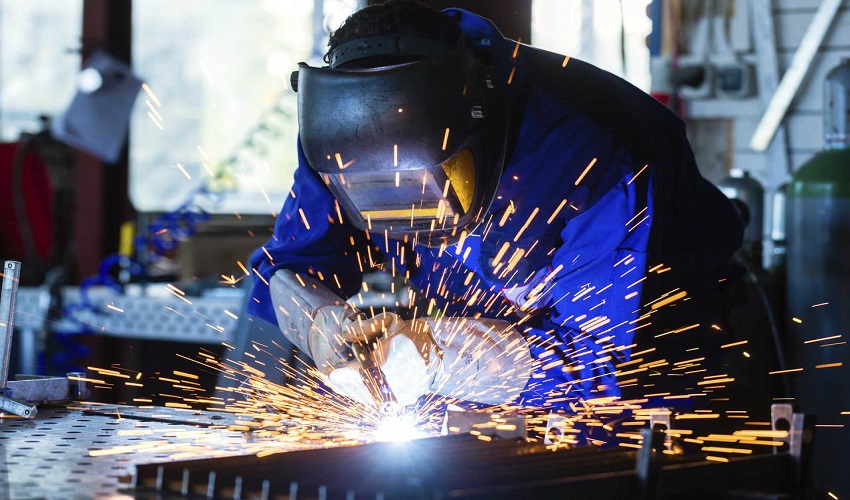Comprehensive Analysis of Cutting-Edge Techniques in Steel Fabrication Industry
As the steel construction industry continues to evolve, the combination of sophisticated methods has come to be crucial for staying affordable and fulfilling the needs of modern production requirements. In this dynamic sector where modern technology plays a critical function, recognizing the nuances of these sophisticated methods is not simply a choice however a requirement for those looking to create ahead in the ever-evolving world of steel construction.
Laser Reducing Improvements
In the realm of steel fabrication, laser reducing advancements have actually reinvented the precision and efficiency of metal shaping processes. By utilizing the power of concentrated laser light beams, manufacturers can currently accomplish unrivaled degrees of accuracy when puncturing numerous kinds of steels. This innovation makes it possible for detailed layouts to be performed with minimal material waste, making it a cost-efficient solution for sectors needing high precision elements.
Among the key advantages of laser cutting is its capacity to handle a large range of materials, including stainless-steel, aluminum, and carbon steel, effortlessly. The procedure produces tidy, burr-free edges, removing the need for extra completing actions. Additionally, the non-contact nature of laser cutting reduces the threat of material contamination, resulting in better output.
Moreover, laser cutting equipments can be programmed to make swift, specific cuts, dramatically reducing production time contrasted to traditional cutting methods. This rate and accuracy make laser cutting especially appropriate for mass manufacturing environments where efficiency is paramount. As technology proceeds to breakthrough, laser cutting is positioned to play a significantly essential duty in the steel manufacture sector.

CNC Machining Innovations
The advancement of CNC machining modern technologies has actually introduced a brand-new period of accuracy and efficiency in the steel manufacture sector. Computer Numerical Control (CNC) machines have changed steel construction by offering unrivaled precision and repeatability in the manufacturing process. steel fixing. One of the vital technologies in CNC machining is the combination of innovative software application systems that enable real-time monitoring and changes, causing boosted efficiency and quality assurance
Moreover, the advancement of multi-axis CNC equipments has actually permitted the manufacture of intricate steel elements with complex designs that were previously challenging to generate. These machines can do a variety of machining operations, including milling, exploration, transforming, and grinding, all with high levels of accuracy.
In addition, the consolidation of automation and robotics in CNC machining has structured manufacturing processes, reduced lead times, and reduced the margin of mistake. This assimilation of cutting-edge technologies not only boosts effectiveness but additionally makes certain regular quality throughout all made steel components. In verdict, CNC machining technologies continue to drive advancements in the steel fabrication industry, establishing new criteria for precision and productivity.
Automated Welding Technologies
Automated welding modern technologies have reinvented the steel fabrication industry, enhancing performance and precision in the welding procedure. These sophisticated technologies utilize computer-controlled systems to automate the welding procedure, resulting in greater efficiency degrees and boosted weld top quality. Among the crucial advantages of automated welding is the capability to execute complex welds with constant accuracy, reducing the probability of mistakes and revamp.
Robotic welding systems go to the center of automated welding technologies, using unmatched rate and accuracy. These systems can take care of a large range of welding tasks, from easy to intricate, easily (Alpha reo). By using sophisticated sensors and software program, robot welders can adapt to variations in material and joint geometry, making certain an uniform and trusted weld
Moreover, automated welding innovations boost work environment safety by minimizing the exposure of human welders to hazardous fumes and extreme warmth. As the steel fabrication market proceeds to develop, including automated welding innovations will be crucial for companies seeking to stay competitive and fulfill the growing needs for top notch welded items.
Robotics Assimilation in Construction
Utilizing robot systems in manufacture procedures has come to be a crucial method for improving performance and precision in contemporary production atmospheres. Robotics combination in steel manufacture uses a myriad of benefits, including raised productivity, enhanced top quality control, basics and boosted safety procedures. These sophisticated robot systems are outfitted with innovative sensing units and programs abilities, enabling them to do intricate jobs with a high level of precision and repeatability.
Among the vital benefits of robotics integration in steel fabrication is the capacity to automate repeated tasks, such as product handling, reducing, welding, and assembly procedures. This not only accelerates manufacturing cycles however likewise reduces the risk of human mistake, causing higher total item high quality. Additionally, robots can run 24/7, significantly boosting manufacturing output and conference tight task due dates.

3D Printing in Steel Production
Having transformed the steel fabrication sector via robotics integration, the expanding expedition of 3D printing in steel manufacturing is poised to more advancement the world of modern-day manufacturing methods. 3D printing, likewise recognized as additive manufacturing, supplies unprecedented style flexibility and complexity, making it possible for the production of complex steel frameworks that were previously unattainable via standard production approaches. By utilizing computer-aided style (CAD) software application, makers can specifically regulate the layer-by-layer deposition of steel material, resulting in get rid of enhanced browse around these guys capabilities and geometries.
One of the essential benefits of 3D printing in steel production is its capacity to reduce material waste dramatically. Unlike subtractive production processes where excess product is cut away, 3D printing only uses the essential amount of steel required for the final component. This performance not only brings about cost financial savings however likewise aligns with lasting manufacturing practices by minimizing ecological influence.
Moreover, 3D printing enables quick prototyping and customization, permitting the production of small batches of intricate steel parts with brief lead times. As the innovation continues to develop and come to be much more available, its integration right into mainstream steel construction procedures is expected to drive development and efficiency across the industry.
Verdict
In final thought, the steel fabrication industry has seen substantial innovations in strategies such as laser cutting, CNC machining, automated welding, robotics assimilation, and 3D printing. These sophisticated technologies have actually transformed the method steel products are manufactured, causing enhanced cost-effectiveness, accuracy, and effectiveness. Continued investment in these ingenious methods is vital for check the industry to remain affordable and meet the demands of modern-day manufacturing processes.
As the steel manufacture sector proceeds to progress, the assimilation of cutting-edge techniques has ended up being necessary for remaining competitive and satisfying the demands of modern-day manufacturing criteria.One of the crucial advantages of laser cutting is its capability to handle a vast array of materials, including stainless steel, aluminum, and carbon steel, with ease.Automated welding innovations have revolutionized the steel construction sector, boosting effectiveness and accuracy in the welding process.Having actually reinvented the steel fabrication industry via robotics combination, the expanding exploration of 3D printing in steel manufacturing is positioned to additional advance the realm of modern-day manufacturing methods.In verdict, the steel construction sector has actually seen significant innovations in methods such as laser cutting, CNC machining, automated welding, robotics integration, and 3D printing.